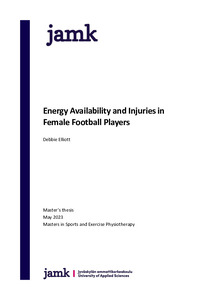Energy Availability and Injuries in Female Football Players
Elliott, Debbie (2023)
Elliott, Debbie
2023
All rights reserved. This publication is copyrighted. You may download, display and print it for Your own personal use. Commercial use is prohibited.
Julkaisun pysyvä osoite on
https://urn.fi/URN:NBN:fi:amk-2023060621836
https://urn.fi/URN:NBN:fi:amk-2023060621836
Tiivistelmä
The popularity of women’s football has been rising steadily since the first world cup in 1991. As the interest and number of participants grow, so does the need for more focused research on female players.
Football is a sport with a high injury incidence, therefore, one of the key areas of research is in injury prevention. An area of injury prevention that has not received much attention is that of energy availability (EA). Low EA has been linked to numerous negative effects on the physiological systems, including the endocrine, reproductive, metabolic, and adrenal systems. These effects may influence athletic health in many ways including increased risk of illness, decreased strength and coordination, and poor training responses, which may lead to injuries.
This study aimed to address this research gap and contribute to the development of comprehensive injury prevention strategies tailored specifically for women in football by answering the question: is there a relationship between EA and injury risk in the female football player?
Data, including EA from food and exercise diaries, the LEAF-Q questionnaire, injury and illness incidence using the OSTRC-H questionnaire, and body composition on 46 female first-division athletes were collected in collaboration with the KIHU training center over a one year period.
The study found a high prevalence of athletes (77.4%) who had energy availability levels below the recommended threshold and a high incidence of injuries and illness (median: 2). High LEAF-Q scores were associated with increased risk of injuries, and more time off of sport due to injury and illness.
Coaches and athletes need to be educated on the role nutrition plays in athletic performance. This education should include the different fuel sources the body requires, with an emphasis on carbohydrates, as well as how to fuel to match exercise energy demands. The LEAF-Q questionnaire should be used as a screening tool to identify athletes at risk of future injuries and illness, and prevention strategies implemented with the results. Future research on EA should use more objective measures of EA in combination with validated outcome measures.
Football is a sport with a high injury incidence, therefore, one of the key areas of research is in injury prevention. An area of injury prevention that has not received much attention is that of energy availability (EA). Low EA has been linked to numerous negative effects on the physiological systems, including the endocrine, reproductive, metabolic, and adrenal systems. These effects may influence athletic health in many ways including increased risk of illness, decreased strength and coordination, and poor training responses, which may lead to injuries.
This study aimed to address this research gap and contribute to the development of comprehensive injury prevention strategies tailored specifically for women in football by answering the question: is there a relationship between EA and injury risk in the female football player?
Data, including EA from food and exercise diaries, the LEAF-Q questionnaire, injury and illness incidence using the OSTRC-H questionnaire, and body composition on 46 female first-division athletes were collected in collaboration with the KIHU training center over a one year period.
The study found a high prevalence of athletes (77.4%) who had energy availability levels below the recommended threshold and a high incidence of injuries and illness (median: 2). High LEAF-Q scores were associated with increased risk of injuries, and more time off of sport due to injury and illness.
Coaches and athletes need to be educated on the role nutrition plays in athletic performance. This education should include the different fuel sources the body requires, with an emphasis on carbohydrates, as well as how to fuel to match exercise energy demands. The LEAF-Q questionnaire should be used as a screening tool to identify athletes at risk of future injuries and illness, and prevention strategies implemented with the results. Future research on EA should use more objective measures of EA in combination with validated outcome measures.
